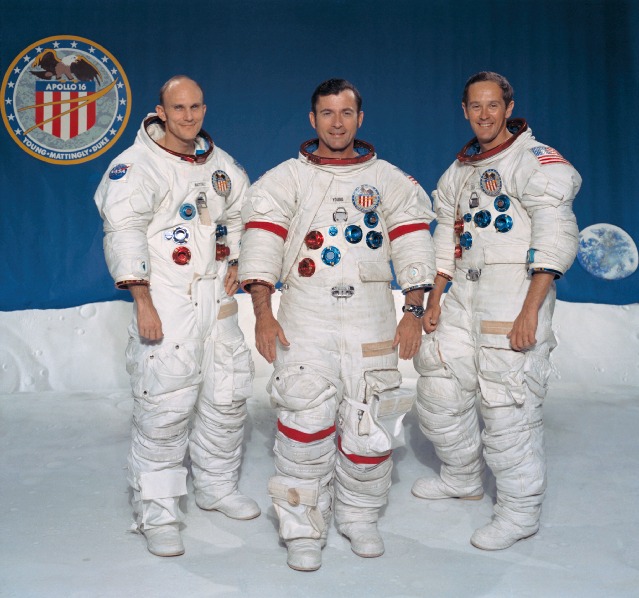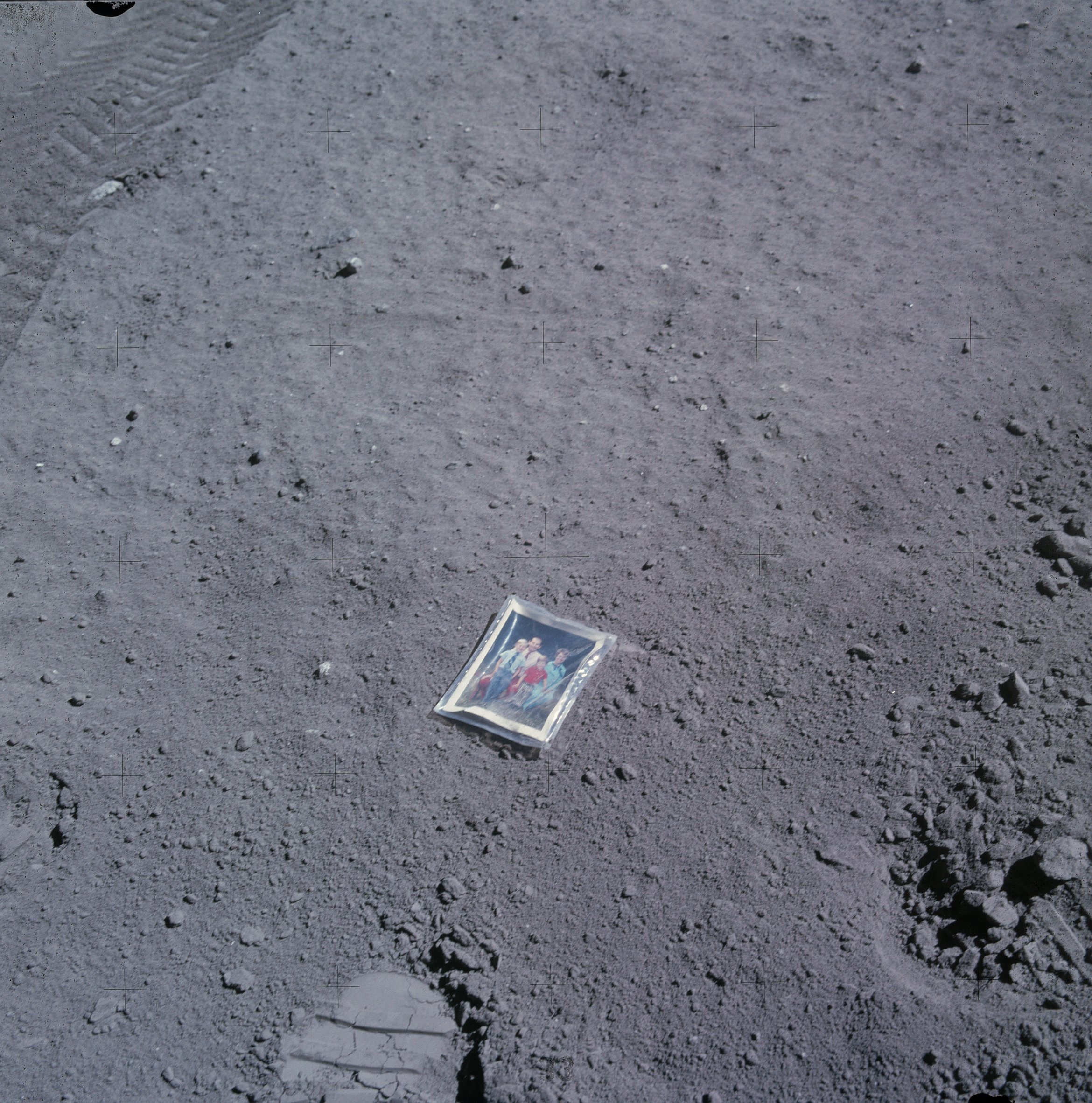Apollo 16: Exploring the Highlands
Apollo 16 was the second-to-last mission of the Apollo program and the fifth to land humans on the moon. Apollo 16 launched on April 16, 1972, and landed at the Descartes highlands, a lunar highland area near the Descartes crater. While there, the crew searched for volcanic rocks.
Although the astronauts didn't come back with the rocks they were searching for, their skill in picking out geologic targets and their ability to cope with changing fortunes made this mission a highlight of scientific discovery on the moon. [Apollo 16: NASA's 5th Moon Landing with Astronauts in Pictures]
The Apollo 16 astronauts
Cmdr. John Young was among NASA's most seasoned astronauts, having already spent a decade in the career. The former U.S. Navy aviator flew twice in the Gemini program, flying as co-pilot in the first mission (Gemini 3, 1965) and commanding Gemini 10 (1966), which rendezvoused with two separate target vehicles in space. With the Apollo program, Young was the command module pilot on Apollo 10(1969) and helped perform the first docking above the surface of the moon. After Apollo, Young went on to command the first space shuttle mission (STS-1, 1981) and a second space shuttle mission in 1983, called STS-9.
Apollo 16 command module pilot Ken Mattingly was selected in 1966. He got a second chance to go to the moon after he was pulled from the Apollo 13 mission because of a medical concern. Before joining NASA, he was a Navy aviator. After Apollo 16, Mattingly commanded two space shuttle missions: STS-4 in 1982 and STS-51C in 1985.
Charles Duke, the lunar module (or lunar lander) pilot, is perhaps best known as being the CapCom during the Apollo 11 landing, who said, "You've got a bunch of guys about to turn blue down here," after the crew landed with a few drops of fuel remaining. Duke was a U.S. Air Force pilot instructor when NASA selected him as an astronaut in 1966. Apollo 16 was Duke's only spaceflight.

Balky engine and snagged cable
Scientists suspected that Apollo 16's destination, the Descartes highlands, contained volcanic rocks. Geologists were hoping to get samples of these rocks to find out how the moon's interior was formed.
The spacecraft reached lunar orbit on April 19. Shortly after the lunar module Orion separated from the command module Casper, Mattingly noticed the command module engine vibrating strangely when he touched one of the controls in the backup system.
Uneasily, the crew circled the moon for several hours in their two spacecraft as Mission Control decided whether it was safe to proceed. After analyzing the data, Houston gave the thumbs-up, and Orion descended successfully to the moon's surface.
The next day, Young stood on the moon for the first time with his fists raised in happiness. "There you are, our mysterious and unknown Descartes highland plains. Apollo 16 is going to change your image," he said.
Duke and Young's first job was to deploy a package of several experiments on the surface to measure properties of the local environment. All Apollo astronauts knew how hard it was to see your feet and feel what they were touching through the bulky spacesuit. Nonetheless, Young accidentally pulled a vital cable free from a heat flow experiment when his boot snagged on the cable, ruining the experiment.
Apologizing profusely, the astronauts finished setting up the package and moved on to their next tasks. They drove the lunar rover to two geologic locations, finding only sedimentary breccia rocks, which are rocks composed of various mineral fragments, and not the volcanic ones geologists had hoped to find.
Breccias and a big rock
Duke and Young never found volcanic rocks while roaming around the moon's surface. On their second day in the rover, they drove to a set of five craters on Stone Mountain, a large hill. While there, the astronauts collected rocks that showed how meteor impacts had kicked up debris to form the hills around them.
Observers of the Apollo 16 mission later commented on how self-assured the crew appeared as they used their equipment and walked around the moon. The astronauts weren't afraid to kneel, jump high, or to pick up their rover and move it if it wasn't sitting in quite the right spot. Eight people had walked on the moon before Apollo 16, and Young and Duke had learned from watching their extravehicular activities.
That's not to say everything went smoothly. For example, Young accidentally snagged his hammer against part of the dust guard of the rover and broke it off. This resulted in the astronauts being showered with rock-filled dust as they drove around the moon's surface. But they adapted as best as they could.
On their third day on the moon, the crew had to cut operations short because they landed so late on their first day, but they squeezed in time to visit North Ray Crater. While they were working, they spotted a large rock in the distance and went sprinting toward it. Amused mission controllers watched as the astronauts got smaller and smaller on the TV screen. "And as our crew sinks slowly in the west," said astronaut and geologist Jack Schmitt, which drew laughter from others in the control room.
The rock, later dubbed House Rock, was a gigantic breccia (a rock composed of a conglomerate of broken minerals), showing the odds of any volcanic activity in the region were slim.
The command module Casper landed safely in the Pacific on April 27, carrying a load of rocks that turned out to be mostly breccias. Although the crew found something different from what experts had expected, the trove of rocks would provide scientists many hours of study in the decades to come.

Apollo 16 legacy
The 50th anniversary of Apollo 16 is in 2022. The current location of Casper is at the Alabama Space and Rocket Center in Huntsville. Orion's upper stage impacted the moon, although NASA is unsure of the exact location.
On his final day on the lunar surface, Duke placed a photo of his family on the ground and took pictures of it. The photo shows Duke, his wife, Dorothy, and their sons, Charles and Thomas. He left the photo on the moon, where it remains today.
NASA had one more crewed mission to the moon, called Apollo 17, later in 1972. The agency then shifted its attention to low Earth orbit activities, principally through the space shuttle and International Space Station programs. The agency is working on a deep-space spacecraft called Orion that could bring astronauts to the moon or to Mars. NASA is also developing a lunar space station, called the Deep Space Gateway.
Editor's Note: This story was updated to reflect a correction on Oct. 3 at 9:52 a.m. EDT. The original article incorrectly stated that Apollo 16 was Mattingly’s only spaceflight.
Join our Space Forums to keep talking space on the latest missions, night sky and more! And if you have a news tip, correction or comment, let us know at: community@space.com.
Get the Space.com Newsletter
Breaking space news, the latest updates on rocket launches, skywatching events and more!

Elizabeth Howell (she/her), Ph.D., was a staff writer in the spaceflight channel between 2022 and 2024 specializing in Canadian space news. She was contributing writer for Space.com for 10 years from 2012 to 2024. Elizabeth's reporting includes multiple exclusives with the White House, leading world coverage about a lost-and-found space tomato on the International Space Station, witnessing five human spaceflight launches on two continents, flying parabolic, working inside a spacesuit, and participating in a simulated Mars mission. Her latest book, "Why Am I Taller?" (ECW Press, 2022) is co-written with astronaut Dave Williams.










